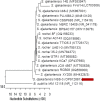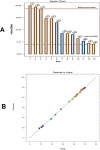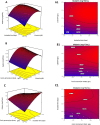Bioproduction and optimization of newly characterized melanin pigment from Streptomyces djakartensis NSS-3 with its anticancer, antimicrobial, and radioprotective properties
- PMID: 38229042
- PMCID: PMC10792909
- DOI: 10.1186/s12934-023-02276-y
Bioproduction and optimization of newly characterized melanin pigment from Streptomyces djakartensis NSS-3 with its anticancer, antimicrobial, and radioprotective properties
Abstract
Background: Melanin is a natural pigment that is considered a promising biomaterial for numerous biotechnological applications across several industries. Melanin has biomedical applications as antimicrobial, anticancer, and antioxidant properties. Additionally, in the pharmaceutical and cosmetic industries, it is used in drug delivery and as a radioprotective agent. Also, melanin has environmental uses in the fields of bioremediation and the food industry. The biosynthesis of melanin pigment is an area of interest for researchers due to its multifunctionality, high compatibility, and biodegradability. Therefore, our present work is the first attempt to characterize and optimize the productivity of melanin pigment from Streptomyces djakartensis NSS-3 concerning its radioprotection and biological properties.
Results: Forty isolates of soil actinobacteria were isolated from the Wadi Allaqui Biosphere Reserve, Egypt. Only one isolate, ACT3, produced a dark brown melanin pigment extracellularly. This isolate was identified according to phenotypic properties and molecular phylogenetic analysis as Streptomyces djakartensis NSS-3 with accession number OP912881. Plackett-Burman experimental design (PBD) and response surface methodology (RSM) using a Box-Behnken design (BBD) were performed for optimum medium and culturing conditions for maximum pigment production, resulting in a 4.19-fold improvement in melanin production (118.73 mg/10 mL). The extracted melanin pigment was purified and characterized as belonging to nitrogen-free pyomelanin based on ultraviolet-visible spectrophotometry (UV-VIS), Fourier transform infrared (FT-IR), Raman spectroscopy, scanning electron microscopy (SEM), energy dispersive X-ray spectroscopy (EDX), and NMR studies. Purified melanin demonstrated potent scavenging activity with IC50 values of 18.03 µg/mL and revealed high potency as sunscreens (in vitro SPF = 18.5). Moreover, it showed a nontoxic effect on a normal cell line (WI38), while it had a concentration-dependent anticancer effect on HCT116, HEPG, and MCF7 cell lines with IC50 = 108.9, 43.83, and 81.99 µg/mL, respectively. Also, purified melanin had a detrimental effect on the tested MDR bacterial strains, of which PA-09 and SA-04 were clearly more susceptible to melanin compared with other strains with MICs of 6.25 and 25 µg/mL, respectively.
Conclusion: Our results demonstrated that the newly characterized pyomelanin from Streptomyces djakartensis NSS-3 has valuable biological properties due to its potential photoprotective, antioxidant, anticancer, antimicrobial, and lack of cytotoxic activities, which open up new prospects for using this natural melanin pigment in various biotechnological applications and avoiding chemical-based drugs.
Keywords: Actinobacteria; Antimicrobial; Melanin bioproduction; Radioprotection; Response surface optimization.
© 2024. The Author(s).
Conflict of interest statement
The authors declare no competing interests.
Figures












Similar articles
-
Streptomycetes as Microbial Cell Factories for the Biotechnological Production of Melanin.Int J Mol Sci. 2024 Mar 5;25(5):3013. doi: 10.3390/ijms25053013. Int J Mol Sci. 2024. PMID: 38474259 Free PMC article. Review.
-
Bioproduction, characterization, anticancer and antioxidant activities of extracellular melanin pigment produced by newly isolated microbial cell factories Streptomyces glaucescens NEAE-H.Sci Rep. 2017 Feb 14;7:42129. doi: 10.1038/srep42129. Sci Rep. 2017. PMID: 28195138 Free PMC article.
-
Bioproduction, purification and physicochemical characterization of melanin from Streptomyces sp. strain MR28.Microbiol Res. 2022 Oct;263:127130. doi: 10.1016/j.micres.2022.127130. Epub 2022 Jul 16. Microbiol Res. 2022. PMID: 35870343
-
Optimization of melanin pigment production from the halotolerant black yeast Hortaea werneckii AS1 isolated from solar salter in Alexandria.BMC Microbiol. 2022 Apr 8;22(1):92. doi: 10.1186/s12866-022-02505-1. BMC Microbiol. 2022. PMID: 35395716 Free PMC article.
-
Melanin pigment of Streptomyces puniceus RHPR9 exhibits antibacterial, antioxidant and anticancer activities.PLoS One. 2022 Apr 25;17(4):e0266676. doi: 10.1371/journal.pone.0266676. eCollection 2022. PLoS One. 2022. Retraction in: PLoS One. 2022 Aug 3;17(8):e0272186. doi: 10.1371/journal.pone.0272186. PMID: 35468144 Free PMC article. Retracted.
Cited by
-
Pigments from pathogenic bacteria: a comprehensive update on recent advances.World J Microbiol Biotechnol. 2024 Jul 20;40(9):270. doi: 10.1007/s11274-024-04076-x. World J Microbiol Biotechnol. 2024. PMID: 39030429 Review.
-
Streptomycetes as Microbial Cell Factories for the Biotechnological Production of Melanin.Int J Mol Sci. 2024 Mar 5;25(5):3013. doi: 10.3390/ijms25053013. Int J Mol Sci. 2024. PMID: 38474259 Free PMC article. Review.
-
Characterization of melanin from the fungus Scolecobasidium Musae and its antioxidant and photoprotective properties.Arch Microbiol. 2025 Mar 6;207(4):77. doi: 10.1007/s00203-025-04279-2. Arch Microbiol. 2025. PMID: 40047961
-
Harnessing the power of Neobacillus niacini AUMC-B524 for silver oxide nanoparticle synthesis: optimization, characterization, and bioactivity exploration.Microb Cell Fact. 2024 Aug 6;23(1):220. doi: 10.1186/s12934-024-02484-0. Microb Cell Fact. 2024. PMID: 39107838 Free PMC article.
-
A review on bacteria-derived antioxidant metabolites: their production, purification, characterization, potential applications, and limitations.Arch Pharm Res. 2025 Apr;48(4):253-292. doi: 10.1007/s12272-025-01541-5. Epub 2025 Apr 10. Arch Pharm Res. 2025. PMID: 40208553 Free PMC article. Review.
References
-
- Ibrahim W, Olama Z, Abou-elela G, Ramadan H, Hegazy G, El Badan D. Exploring the antimicrobial, antiviral, antioxidant, and antitumor potentials of marine Streptomyces tunisiensis W4MT573222 pigment isolated from Abu-Qir sediments, Egypt . Microb Cell Factories. 2023;22:94. doi: 10.1186/s12934-023-02106-1. - DOI - PMC - PubMed
-
- Nayaka S, Hiremath H, Chakraborty B, Swamy PS, Basavarajappa DS, Nagaraja SK, Rudrappa M, Bhat MP, Airodagi D, Murigennavar MS. Isolation, characterization, and identification of Streptomyces cinereoruber strain RSA-14. J Appl Biol Biotech. 2020;8(4):1–6. doi: 10.7324/JABB.2020.80401. - DOI
-
- Sreenivasa N, Muthuraj R, Bidhayak C, Meghashyama PB, Pallavi SS, Shashiraj KN, Halaswamy HM, Dhanyakumara SB, Dattatraya A, Hagedc K. A potential bioactive secondary metabolites and antimicrobial efficacy of Streptomyces thermocarboxydus strain KSA-2, isolated from Kali River Karwar. Curr Res Microbial Infect. 2020;1(1):5–13. doi: 10.31559/CRMI2020.1.1.2. - DOI
-
- Kulkarni A, Desai SV, Shet AR. Isolation and characterization of pigment producing actinomycetes from different sources. Res J Pharm Biol Chem Sci. 2017;8(3):101–109.
MeSH terms
Substances
Supplementary concepts
LinkOut - more resources
Full Text Sources
Molecular Biology Databases

